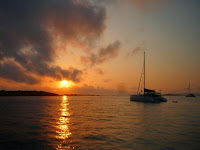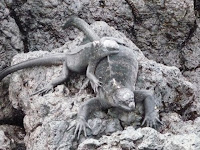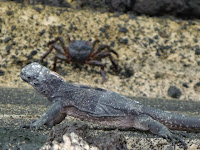[Kyle]On the morning of our second day in Galapagos we were packed up and ready to go by sunrise. At 6:30am I tried calling the water taxi on the VHF (we’d verified the day before that they start early, at 5:30 in the morning!). No luck. A few minutes later I tried again: still nothing. I selected a few other possible channels and tried again in English and in Spanish: still no response. After a while, I started to worry that our radio was faulty and I made a general call for a radio check and got a response “yeah, we’ve heard you every time, they don’t answer their radios”. What the hell kind-a business model is that for a water taxi?
There was no time to get our dingy out and ready (it was setup in life raft mode and would take a while, plus we were quite a way from the dinghy dock in waters we were not familiar with – there was no way we’d make it to shore in time for our tour. It was now 7:10 and we were starting to get a little nervous. JC had sent them out the first time so I tried him on the VHF – no luck.
By now our many radio calls and repeated waving at distant taxis from the deck had attracted the attention of others. The owner of the boat Little Explorers a fellow cruiser we’d met in Panamá, came by in his dingy and asked if we wanted a ride to shore.
Gees, that was nice of him, but “Er… no thanks”, he looked a little busy, he had three naked toddlers and a dinghy full of laundry and by now we’d seen a water taxi headed roughly our way. We asked instead if he could be sure to not let that water taxi return to shore without sending him our way.
“Sure, no problem, you guys have a nice day”. And off he sped.




It seems we were not the only ones up early today
We made it to the dock at 7:27, the airline pilot in me gets nervous when I’m supposed to be somewhere at 7:25 and my watch says 7:27. I tried to reassure myself that it was probably more laid back here and they wouldn’t leave if we were only two minutes late (they would have seen the water taxi headed their way).
By 7:40 the place was still deserted and I wasn’t so sure. We tried JC a couple of times on our hand held radio but got no response. Hmmm… Well, now what do we do?
We were about to find a bench and figure out a back up plan when JC called us.
Maryanne answered “Hi JC, we are at the dock and there is no sign of our tour guide”.
JC “Tour, what tour?”
Maryanne: “The tour you scheduled for us, the volcano tour”.
JC: “No, there is no tour, you need to get to the port captain’s office right away, I’m waiting for you there”.
Maryanne and I looked at each other confused and annoyed.
She continued: “What do you mean? No tour? You told us to be ready for pick up at 7:25”
JC: “There is no tour! The port captain’s office must take priority, where are you now?”.
Maryanne: “We are at the dock, where you told us to wait”.
JC: “You need to get here as soon as you can, I’m waiting”.
What the hell? We started walking into town. About half way we were intercepted by JC coming from the other direction on his bicycle.
Maryanne started off “JC, I don’t understand, yesterday you told us we could go to the port captain’s office after the tour. What happened to our tour?”
“I cancelled it” JC Snapped
And then, in the same condescending voice he’d used on her yesterday “You have not completed entry formalities, you can’t do anything before going to the port captain”.
Alright, now I had lost my patience with this guy. I barked “That is not what you said yesterday JC”.
Maryanne remained calm and diplomatic “JC, why did you do that, you know we only have a few days on the island, we really wanted to see the volcano. You’ve cancelled our trip and taken a day away from us”.
He didn’t answer, but marched ahead sulking. He was mad at us for being mad at him.
At the port captain’s office he did little more than follow us in, gesture our direction to the port captain and leave. He had to be there for that?
The port captain seemed surprised to see us “What are you here for?”. He hadn’t expected us until the afternoon. We had difficulty understanding what he wanted from us with no common language. Eventually we surmised they needed to collect our $36 port fee. OK, good, stamp, stamp, stamp, sign. “Regresso a diez horas” (return at 10am). “Er… OK, why?” “Regresso a diez horas”
Well, the morning is definitely shot now.
We decided to use the waiting time to get some breakfast and take a look at the town surrounding the Port Captain’s office. Most restaurants had just opened and only had one or two customers. We spotted one full of locals and figured that was a good sign – we took a seat. We managed to both stuff ourselves as well as get coffee, tea, and slow wifi for only $12, including tip, for the pair of us. The thing Maryanne ordered came with a yummy side dish made of plantains and cheese that kind of resembled hash.



Exploring the beach
With our tanks full, we adventured further about town waiting for 10am. Puerto Villamil was not as I’d expected at all, although to be honest, my expectations were vague to begin with. I had expected the most remote settlement on the least populous island of one of the worlds most important (or at least famous) biological habitats to be sparse and functional (like an Antarctic research station, minus the snow). Instead, it kind of resembled any other off the beaten path beach town. There were lots of places offering tours, lots of restaurants/beach bars, and lots of small hotels and rooming houses that seemed to cater mostly to back packer and surfer clientele.
We walked along the beach to an observation platform, and before we’d even reach the stairs, we were distracted by an adorable little iguana sunning himself. We followed him around for a bit, trying to get a picture as he scurried away from us, we didn’t get far before we realized that there were load of others, they were everywhere. Their dark gray skin perfectly matched the color of the volcanic rocks upon which whole families were sunning themselves. In contrast to the iguanas, there were lots of bright read crabs nervously flitting about.










Iguanas EVERYWHERE! Oh, and colorful crabs
At 10am, we returned to the Port Captain’s office. The man who’d directed us to come back at 10 wasn’t there. There was some confusion as to why we had been told to come back, so the current guy started all over asking where we had come from and when and where we were going. We showed him copies of everything we had, including the receipts from earlier but to be honest we didn’t know why we were there either! After consulting the full complement of office staff, he decided that we needed to pre-pay our departure fees since it was within 72 hours of our departure. Oh, no problem, sign here, stamp, stamp, pay $15, take your receipt. Buenos dias, buen viaje.
Just as we were finishing up. JC came in with another boater, saw us and asked what we were still doing there.
“They told us to come back” I said
JC: “What for?”
Me: “We think it's To pay our departure fees”.
JC: “Departure fees, you are not leaving until Friday, why did you come back?”
Me: “Because they told us to”.
He then turned to the officer and started questioning him in Spanish. I could not understand all of the details but it seemed like the jist of the officer’s side of the argument was something like “calm down buddy, what’s the big deal”.
JC gave the room a sour look and then went to leave without saying goodbye. Before the door shut behind him he came back in and said to us your passports should be coming in today from Santa Cruz, call me on the radio later and we can arrange to meet up and get them back to you.
Maryanne asked “So since we’ve paid the departure fees, does that mean we’ll then be done with all the official paperwork?”
JC: “Yes, you’ll be completely done. All you’ll have to do is come to the Port Captain’s office with your passports before you leave. There is nothing left to do”.
Maryanne: “So just that one thing; bring our passports here?”
JC: “No, once you have your passports, you are finished with everything. Just bring them here, there is nothing you have to do”.
Ugh, not this again!
Maryanne: “Thanks JC, got it!”.
Once he was gone I asked the port Captain what we had to do. Even though the conversation was in Spanish it was way less difficult than trying to communicate with JC in English.
The port captain basically confirmed that we’d already paid all our fees, come in the night before you leave and we’ll put the departure stamp in the passports and give us our Zarpe (outbound clearance papers).
All righty then! The good thing was that once we have our passports we would not have to upset JC any more.




About town in Puerto Villamil
We realized that since we were prepared and packed for a hike, and had no snorkeling gear with us, we couldn’t sign up for any of the afternoon tours. We’d need to entertain ourselves for the rest of the day. We plucked the local things from our list that didn’t require a guide (or snorkel gear). We were to walk to the Galapagos tortoise-breeding center. From town we took an elevated boardwalk about a mile to the tortoise center.
Almost immediately after we stepped on to the trail the quiet streets of Pueto Villamil gave way to a scene from another world. The wooden trail passed over brightly colored salt flats ringed by mangroves and cactus. Lava colored iguanas were sunning themselves on every available surface as sand pipers and flamingos searched the mud for food. Further along we passed through a field of lava that went as far as we could see, it was several feet thick and was endlessly buckled and split where it flowed over the ground below and cooled. Cactus and other desert plants were growing out of every crack that had accumulated a little soil.






The trail to the tortoise sanctuary passes through a number of different landscapes
At the breeding center we got to see hundreds of tortoises of various ages, ranging from pocket size hatchlings to mature ones the size of ottomans. They were kept in different pens, separated by size/age and sub-species. The excellent display boards explained how the young were being hunted by introduced species (dogs and rats), while the nests were in danger from being crushed by livestock and donkeys. The breeding center raises them until they are big enough to be safe from all that and then reintroduces them to the wild on remote parts of the islands. They retain some really old tortoises that they rescued from an encroaching lava flow; these tortoises are used to provide many of the new eggs the center can rear.
{Maryanne: we also were surprised to come across a snoring tortoise, and even more surprised when we located the culprit and found him on top of a lady tortoise, obviously NOT snoring.}








Tortoises! Yeah, in Galapagos, just so cool
Even though they don’t do much, and when they do, it’s very slowly, they are fascinating to watch. They seemed curious about us, perhaps they thought we were about to feed them. They would climb right over others like boulders to get to us, rather than take the easier path around any such obstacles. The climbee didn’t seem to mind, they would just tuck into their shell until it was over. I had some come so close to my camera that I actually had to back up to get them in focus and into the shot.
We took the board-walk path back into town, being re-amazed at all the stuff we had seen earlier. At the other end, in town, Maryanne suggested we call JC on the radio about our passports. We played the game of exchanging “you do it”, “no, you do it” looks at each other. I lost and gave him a call. He confirmed the passports were back, and asked if we could meet him at the “Blue Booby” bar in 20 minutes. Perfect, we were just walking right by the place!
We went in to the empty restaurant where the proprietor, a man from California, looking much like a younger Woody Allen, and ordered drinks and told him JC was going to meet us here. “Sure, sure” came the reply “make yourselves comfortable”. He brought us our beers and asked if we wanted any food. We declined at first, but then I realized I was a little puckish so I asked him if he had anything light. He said he’d just made up a batch of chicken soup and there was plenty for me if I’d like. I said “that sounds great, thank you!”.
It wasn’t actually great, that man’s method of butchering a chicken seems to be to throw the whole thing in the hopper of a woodchipper. There were more bones in that soup than in my left arm (including the hand). Still, he meant well.
JC arrived and the three of us did a pretty good job of pretending we all liked each other. He gave us back our passports and a copies of our receipts. He saw my soup and said to Woody “that looks pretty good, I’ll have one too”.
We then made small talk about our upcoming sail and how busy he was. He wished us a good trip and headed for the exit. Woody came out of the kitchen holding a plate with a big bowl of soup and a piece of crusty bread in one hand and utensils in the other. “Hey, JC, you wan’t your soup?”.
Without the slightest hint of a smile he said “Nah, I was only kidding” and walked out. Woody’s look alike looked at us, exchanged shrugs and then sat down to eat JCs soup.
You know, it really wouldn’t surprise me to hear one day that someone had murdered that man in his sleep.





































































